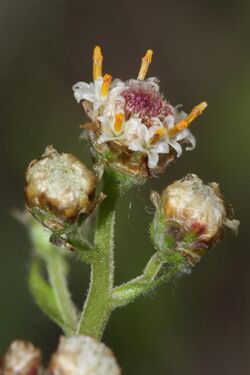Biology:Antennaria
| Antennaria | |
|---|---|

| |
| Antennaria racemosa | |
| Scientific classification | |
| Kingdom: | Plantae |
| Clade: | Tracheophytes |
| Clade: | Angiosperms |
| Clade: | Eudicots |
| Clade: | Asterids |
| Order: | Asterales |
| Family: | Asteraceae |
| Tribe: | Gnaphalieae |
| Genus: | Antennaria Gaertn.[1][2] |
| Synonyms[3] | |
| |
Antennaria is a genus of dioecious perennial herbs in the family Asteraceae, native to temperate regions of the Northern Hemisphere, with a few species (A. chilensis, A. linearifolia, A. sleumeri) in temperate southern South America; the highest species diversity is in North America.[4] Common names include catsfoot or cat's-foot, pussytoes and everlasting.[1][2][5]
Different Antennaria species reach between 10 cm and 50 cm in height. The leaves are basal and often stem leaves. The name Antennaria refers to the projecting stamens seen on the male flowers of some species, resembling insect antennae.[6] [7]
Antennaria species are used as food plants by the larvae of some Lepidoptera species including Vanessa virginiensis (American painted lady),[8] Coleophora pappiferella (which feeds exclusively on A. dioica), Schinia verna (which feeds on several Antennaria species).[citation needed]
Selected species
Hybrids
- Antennaria × erigeroides Greene (pro sp.)
- Antennaria × foliacea Greene (pro sp.)
- Antennaria × macounii Greene (pro sp.)
- Antennaria × oblancifolia E.Nels. (pro sp.)
Gallery
Field pussytoes (Antennaria neglecta) in spring, with flowerbuds and runners
References
- ↑ Jump up to: 1.0 1.1 Gaertner 1791, p. 410.
- ↑ Jump up to: 2.0 2.1 Gaertner 1791, Tab. CLXVII: line drawings of flowers and flower heads of A. dioica.
- ↑ Flann, C (ed) 2009+ Global Compositae Checklist
- ↑ Thapa, Ramhari; Bayer, Randall J.; Mandel, Jennifer R. (2020). "Phylogenomics Resolves the Relationships within Antennaria (Asteraceae, Gnaphalieae) and Yields New Insights into its Morphological Character Evolution and Biogeography". Systematic Botany 45 (2): 387–402. doi:10.1600/036364420X15862837791221. https://zenodo.org/record/4446140.
- ↑ "Antennaria", County-level distribution maps from the North American Plant Atlas (NAPA) (Biota of North America Program (BONAP)), 2013, http://bonap.net/NAPA/TaxonMaps/Genus/County/Antennaria
- ↑ Bayer, Randall J., "Antennaria", in Flora of North America Editorial Committee, Flora of North America North of Mexico (FNA), 19, 20 and 21, New York and Oxford, http://www.efloras.org/florataxon.aspx?flora_id=1&taxon_id=101977
- ↑ Coombes, Allen J. (2012). The A to Z of plant names : a quick reference guide to 4000 garden plants (1st ed.). Portland, Or.: Timber Press. pp. 46. ISBN 978-1-60469-196-2. OCLC 741564356. https://www.worldcat.org/oclc/741564356.
- ↑ Hilty, John (2016). "Plantain-Leaved Pussytoes (Antennaria plantaginifolia)". http://www.illinoiswildflowers.info/savanna/plants/pl_pussytoes.htm.
- Gaertner, Joseph (1791) (in Latin). De Fructibus et Seminibus Plantarum. 2. Sumtibus Auctoris, Typis Academiae Carolinae. https://www.biodiversitylibrary.org/bibliography/53838.
External links
Wikidata ☰ Q602788 entry
 |



